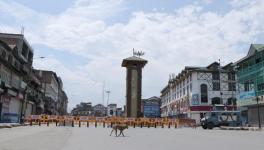Bifurcation of Cantonments: Business Under Nationalist Banner?
Representational use only.Image Courtesy: Wikimedia Commons
A land grab of mammoth proportions could unfold if India does away with Army cantonments. That is how several senior retired military officers view the April 27, Ministry of Defence notification abolishing the Yol cantonment in Himachal Pradesh. This is part of the Central government’s plan to disband all 62 cantonments nationwide and turn some into military stations.
Historians, environmentalists, and residents of cantonments are also unhappy with the decision regarding Yol and the larger idea of doing away with cantonments. The government describes the effort, which will be followed by disbanding the Nasirabad cantonment in Rajasthan, as removing the British colonial legacy. But critics of the plan say it is all about land and profits from selling and buying it at a premium.
Lt Gen (Retd) Vijay Oberoi, former Vice Chief of Army Staff and founder-director of the Centre for Land Warfare Studies says, “The real reason for this bifurcation is that the premium on defence lands has become extremely high on account of the infrastructure developed there. Taking them out of the Army’s control will enable easy disposal in the future, especially when the land mafia is waiting for a bonanza of this nature.”
When first unveiled in 2018, the government’s plan created a storm in Parliament. At the time, the Defence Ministry informed Parliament that the Army itself had suggested the “excision” of civil areas from cantonments and converting military pockets into military stations, but there hardly seems to be a consensus on this issue.
But critics of the plan say disbanding the Yol cantonment might give the government access to 1,100 acres of land, but once prime real estate starts getting developed, it will be at the cost of security, the environment, and the peace and quiet that is typical to cantonments.
There were 56 cantonments at the time of independence. Another six were created after Partition, the last being Ajmer city, notified in 1962. Another reason the government has given for bifurcating cantonments is to allow the military to retain exclusive control of military spaces and installations, which means the civilian areas in the cantonments will merge with local municipalities. The Indian government currently possesses land worth Rs 3.52 trillion, and the office of Defence Estates under the Ministry of Defence is among the largest landowners, owning about 17.99 lakh acres. Of this, approximately 1.61 lakh acres are within the 62 cantonments. The remaining is outside cantonment limits. While the Indian Army has 13.79 lakh acres under its control and management, the Indian Air Force has 1.51 lakh acres, and the Navy has 0.37 lakh acres.
As cities grow and the demand for land rises, cantonment areas have become prime property. In scenic hilly regions such as Dharamsala, Shimla, Dalhousie, Dagshai, Kasauli, Chakrata, Lansdowne, and Wellington, the sale of land in and around cantonments could clock enormous profits. Land in big cities would command an even bigger premium. That’s where, senior defence officials say, the bureaucrat-politician-builder nexus stands to make a killing.
According to Gen (Retd) Rajendra Prakash, “Politicians, who always had their eyes on defence lands, have been given a free hand to take over what they want.” He refers to an effort in Maharashtra’s Pune region, where, many years ago, the Nationalist Congress Party leader Sharad Pawar had wanted the government to take over the Khirkee cantonment. “The Ministry of Defence put its foot down against it then,” says Gen Prakash. “But it no longer enjoys that kind of autonomy,” he says.
Services in cantonments could improve since independence, but the cities and towns around them deteriorated over the same period. So, asks an army officer, “Is the new system aimed to bring both to the lowest common denominator?”
Another senior retired Army officer said the bifurcation is being imposed on the defence services to allow politicians and bureaucrats to wrest control over such valuable real estate. “There is no clear demarcation between military-owned and civilian land and [if it must be done], it must not compromise national security. Take the Delhi Cantonment. In its midst is a large market—how exactly will they be separated? This is the case with many old cantonments,” Prakash says.
Lt Gen (Retd) DB Shekatkar has also described the government’s decision as “dangerous”, which can prove a “serious security threat”.
Residents of cantonments are also upset with the government’s decision. One claim about the bifurcation is that civilians living in cantonments do not get access to welfare schemes such as MG-NREGA and the National Rural Health Mission. But this has not convinced residents, who say the public health services, water supply, sanitation, primary education, and street lighting are far better than civil administrations can provide. Besides, since the government owns the land, the tax burden on them is lower. “We do not want to become a part of dysfunctional and largely corrupt municipalities,” says one civilian resident of the Kasauli cantonment in Himachal Pradesh.
Environmentalists also oppose the bifurcation and warn that thousands of acres of land, with a wealth of green spaces and ancient trees, will be sacrificed when cantonment lands turn into real estate. Cantonments are among the last clean areas left in Indian cities and absorb carbon and other pollutants and provide respite from creaking infrastructure in poorly planned cities.
Oberoi says most cantonments have valuable spaces Army formations need when mobilising for operations, or to accommodate reinforcements, even prisoners of war and refugees, and cater to numerous other military needs. They are buffer zones that secure cantonments and their residents against militant and terrorist infiltrations.
It is not just the military; even the political parties are against the bifurcation. Suryakant Dhasmana, vice president of the Uttarakhand Pradesh Congress Committee, cites the Prem Nagar cantonment in Dehradun to say, “No tall buildings can come up near cantonments as these can prove a threat to military areas. For instance, leading dignitaries attend the Passing Out Parade at the Chetwoode Hall of the Indian Military Academy, and a high-rise structure close by can put lives at risk.”
Recall the Adarsh Housing Scam, in which the court refused to allow a residential tower overlooking the Colaba military zone in Mumbai. The building remains unoccupied to date. Defence land was also misused when the Santushti Complex, established by the Air Force Wives Welfare Association, cropped up on defence land in New Delhi in 1985. A hundred acres valued at Rs 600 crore given to the Secunderabad Cantonment Board in Andhra Pradesh by developers in a land-for-land deal was encroached on by private parties. Demands from residents to create parks and other public facilities could not fructify due to a shortage of funds, creating a permanent nuisance for authorities.
Dhasmana says, “Those living on cantonment land have to follow strict norms and are not allowed to build indiscriminately. Public representatives on the cantonment board fight the board members to enable indiscriminate construction and legalise encroachments. It happened across several cantonments, and the boards have taken strict action against encroachers.”
Shimla-based historian Chandra Haas ‘Raaja’ Bhasin, the co-convenor of INTACH (the Indian National Trust for Art and Cultural Heritage), says the claim that cantonments are a British legacy is fallacious. “Facilities in cantonments have been upgraded enormously since independence. These are places of great historicity and must be taken care of. To protect their summer capital, Shimla, the British created five cantonments around it, including Kasauli, Dagshai, and Solan. Shimla is an essential training command centre, so I find it difficult to understand how the government wants to implement such a plan,” he says.
Another claim is that bifurcating civilian and defence land will help the defence department reduce its management expenses. But figures from 2018 say the expenses of maintaining cantonments were less than Rs 500 crore. This would be an apt time to remember that the Centre has, over time, undermined or overruled the military at various levels—bureaucratic interference in the canteen services and launch of the much-criticised four-year service term for jawans being among the latest. At a time when cities are becoming polluted and green expanses shrinking, the ‘green soul’ of cities are set to face the axe.
The author is an independent journalist. The views are personal.
Get the latest reports & analysis with people's perspective on Protests, movements & deep analytical videos, discussions of the current affairs in your Telegram app. Subscribe to NewsClick's Telegram channel & get Real-Time updates on stories, as they get published on our website.
























